This seemed like it should be such a simple question.
I like this question for two reasons. First, It could be a simple way to gain insight to complex issues of globalization and trade, poverty and fairness. Second, and perhaps more importantly, it seems like an answerable question. Inequality is, basically, empirical and measurable. Sure, global anything is complicated, so these measurements might be uncertain, but the general direction should be well agreed upon.
This is pretty much what I thought before I started writing this post.
Then I googled “Is global inequality increasing?”
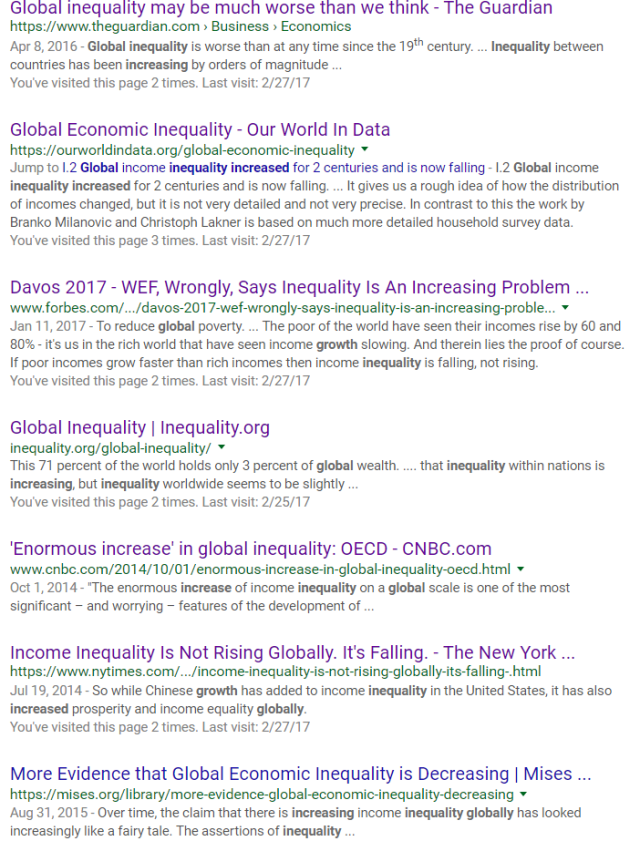
What this does not look like, is a consensus. Based on the headlines, three articles seem to indicate global inequality is rising and three say it is falling.
An Answerable Question
Is that even possible? How could different people come to different conclusions about something that seems so empirical. It’d be like people disagreeing about the reality of climate change.
Global inequality is a big, faceted, topic. This complexity means showing global inequality as increasing or decreasing, may be as simple as just picking a particular way of looking at it. Writing in The Gaurdian, Jason Hickel mentions that in 2000 the people in the richest country made 133 times the income of those living in the poorest. In 1960 that ratio had been 33 times. Tyler Cowen says that “income inequality for the world as a whole has been falling for most of the last 20 years”, citing a paper by Christoph Lakner and Branko Milanovic.
Despite these differing opinions, I maintain that this is an empirical question, which means it has an answer.
Probably.
Decisions
There are many things that can be unequal: life expectancy, education, quality of housing, and, of course, money. Even if one is content to just look at money, there is the choice to look at inequality in income, inequality in wealth, or inequality in consumption.
What is Inequality, exactly?
Inequality is one of those things that’s very easy to agree what it basically means, and not so easy to agree on what it exactly means.
Consider a situation where every member of society saw their income increase by 10%. Did inequality increase? Decrease? Or stay the same?
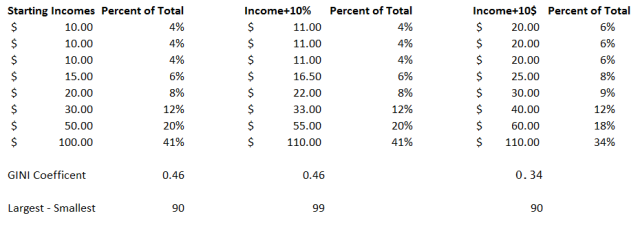
Most people who study inequality on a global level, tend to think about relative inequality. Relative inequality is concerned with what percentage of the total income[1] each person receives. From a relative income perspective, when each person’s income increases by 10% inequality has not changed, as the percentage of the total income each person receives stays the same.
The Gini Coefficient is probably the most commonly used measure of inequality. It is a relative measure of inequality that ranges from 0, everyone having the exact same amount of whatever is being measured (usually income, wealth, or consumption), to 1, one person having everything and everyone else having nothing.
Relative measures are not the only way to think about inequality. In the 10% gain example, while the relative inequality might be the same, the absolute inequality is not. A person with an income of $10 before the increase would have gained $1, while one with an income of $100 would have gained $10. There is an argument that inequality, has in fact increased. If you measure inequality as the difference between the incomes of the richest and poorest, then inequality has gone from 100-10 – 90 to 110 -11 = 99.
If neither of these options appeal, one could use some combination of the two. A measure that considers both relative and absolute changes in income. For example, in the Krtscha Index gains in income are split halfway per the relative share, and halfway in an absolute manner.
Between Country or Within Country
Global income inequality has two different components, between country inequality and within country inequality. These can increase or decrease independently of each other. Both are important.
Within country inequality is important as inequality is perhaps most damaging at the local level. If inequality is fundamentally about fairness, inequality within a society probably feels more unfair than inequality across the world.
Inequality between countries is important as well. Much of the impetus for studying trends in global inequality stems from questions about globalization and trade. One promise of globalization proponents is that increased globalization will help poor countries become rich. This catching up, or convergence, should be reflected in a decline in global between country inequality.
Global inequality can also be looked at as a whole. This looks in income inequality between all the people of the world without bothering about national boundaries. I believe that this gives the best overall view of the trends in income inequality, and is the most appropriate measure for answering the question posed in the title of this post.
Where does global inequality come from?
The extent of global inequality is not really in doubt. Most research gives a global Gini index between 0.6 and 0.7. A Gini index of 0.7 indicates that the world is a more unequal place than nearly any individual country
If given the choice between being a relatively wealthy person in a random, unknown country, or a resident of a wealthy country, but from an unknown place in the income distribution, you’d have a better chance to maximize your absolute income by being by choosing the second option.
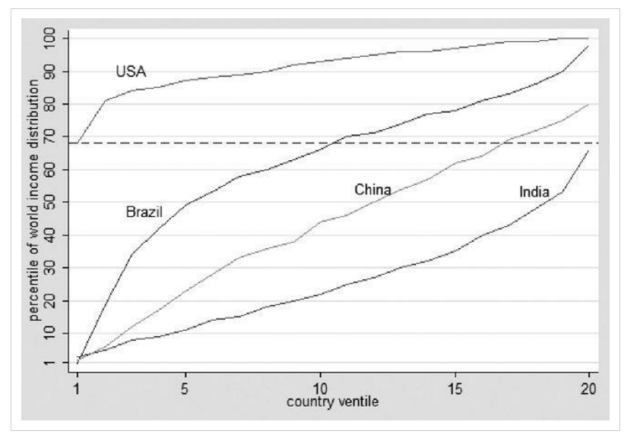
Graph From here, Chart From the book The haves and the have-nots: A brief and Idiosyncratic History of Global Inequality, by Branko Milanovic
This is nicely illustrated by the above chart. This shows the relationship between the within country income distribution, and the global income distribution. The bottom ventile (a ventile is one 20th of a distribution) of the US is still higher than the top ventile in India and the 68th percentile of the global income distribution. Brazil is one of the world’s most unequal countries, which is shown by the fact that the ventiles span nearly the entire range of global incomes.
Between country inequality has not always dominated within country inequality. In the 1800s, the two forms of inequality were much more similar. Since then, as some countries have become much more wealthy, between country inequality has grown to dominate within country inequality.
Within country inequality has been increasing, especially in wealthy countries, especially at the upper end of the distribution.
The Long Term
The world has generally become a more unequal place.
An analysis provided by Bourguignon and Morrisson shows a general increase in inequality between 1820 and 1992. Within country inequality is relatively flat, while between country inequality has risen.
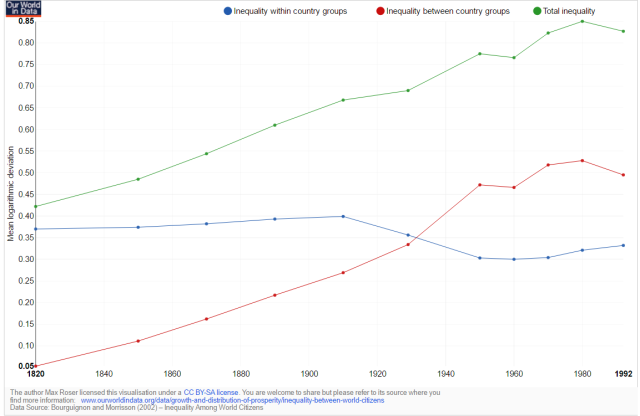
Chart from OurWorldInData. Data from Bourguignon and Morrisson
Global Inequality is Declining?
Neither long term inequality, nor within country inequality provide the conclusion about recent trends in overall inequality.
Using household survey data, Christoph Lakner and Branko Milanovic, come up with estimates for changes in global inequality between 1998 and 2008.
Overall global income inequality is declining. They estimate that global inequality declined slightly over this period (about 2 points on the GINI index).
Maybe.
One issue with using survey data, is that surveys are less effective at discerning the incomes of the very rich and the very poor. When the authors update their estimates, in an attempt to correct for this, they find that there was very little change in global interpersonal inequality between 1998 and 2008.
From this, the answer to the question “is global inequality increasing?” should be something along the lines of “probably not, but it hardly seems to be falling either”.
A Changing Distribution
Even if overall measures of inequality have not changed much. This does not mean that the distribution of income is unchanged.
This chart plots income density on the y-axis and annual income (PPP adjusted 2005 USD-log scale) on the x axis. while the log scaled-x axis is nice for plotting, it makes the distribution look much more centered than it is (chart is from a different paper).
In the late 80s (blue line) there was a two-peaked distribution with one peak near $400 per year and a second smaller one around $10,000. 30 years later (green line) the distribution had shifted to the right-indicating an increase in average income-and the space between the two peaks had filled in.
There is a strong geographical component to this shift. Most of the ‘filling in’ has been due to rising incomes in places like China and India. In the following charts, this is seen by the increase in the right tail of the India and China portions of the distribution.
Absolute Inequality, Increasing Absolutely?
The above is pretty much all calculated using relative measures of income inequality. If more absolute measures are used, it appears that global inequality is rising. This is also true if you look at absolute inequality between countries. There is no contradiction here. It is entirely possible that absolute inequality is rising while relative inequality is falling, or staying still. While It’s probably not wise to ignore absolute inequality altogether, relative inequality is a more appropriate measure for most conversations about global inequality.
This is mostly due to how inequality interacts with economic growth. in nearly all real-world situations when average income increases, absolute inequality increases as well. (Just like the earlier example where all incomes increased by 10%.) This makes absolute inequality a weaker measure for comparing changes in inequality during periods of economic growth.
Conclusions?
While there are many ways of looking at inequality, I would summarize the information on current trends in global inequality with something like the following:
Global income inequality remains very high. While global inequality has generally been increasing, recently these increases appear to have stopped and global inequality may even be declining slightly. Most of this change is due to rising incomes in places like China, as many people move into what is sometimes called the global middle class. Inequality within countries is generally increasing. Absolute Inequality is increasing.
Global Inequality is intimately linked to wealth, economic growth, and poverty. It is not only a mistake to focus on inequality without looking at these topics, but nearly an impossibility. Changes in income inequality and changes in average incomes are two different pieces of the same thing. While estimating changes in global inequality might be a difficult, messy, question, figuring out the appropriate tradeoffs between average wealth, inequality and globalization is a much more difficult one.
Relevant PARTYSHEEPHATS posts
How should global inequality be measured?
Can the gains from trade be redistributed?
Source, References, and Further Reading
Papers:
Bourguignon and Morrisson 2002
Articles and Reports
http://www.conferenceboard.ca/hcp/hot-topics/worldinequality.aspx
https://www.oxfamamerica.org/static/media/files/oxfam-drivers-of-economic-inequality.pdf
http://www.cnbc.com/2014/10/01/enormous-increase-in-global-inequality-oecd.html
https://www.weforum.org/agenda/2016/04/bill-gates-global-inequality-is-falling-faster-than-ever/
Graphs:
https://ourworldindata.org/global-economic-inequality
https://ourworldindata.org/income-inequality/
Books:
Global Inequality, Branko Milanovic, 2016
[1] Income is not always the inequality that is being focused on.
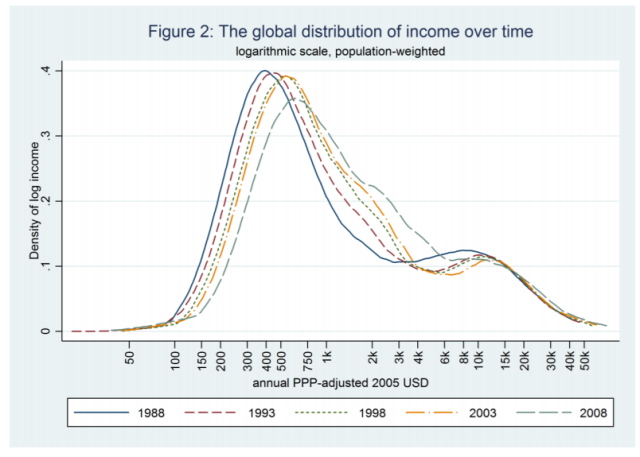
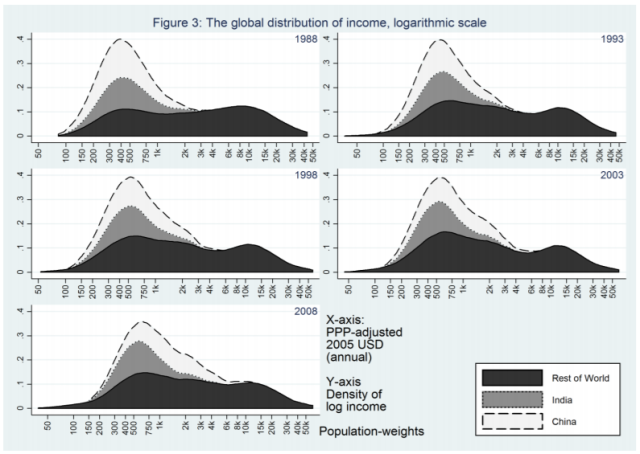
Yay!
Sent from my Verizon, Samsung Galaxy smartphone
LikeLike